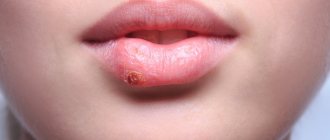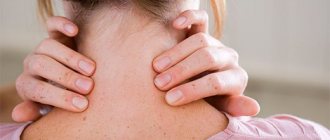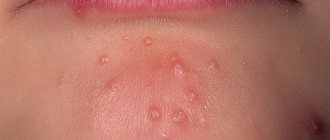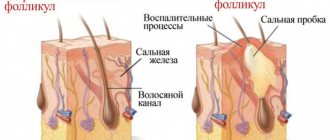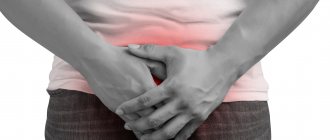If you have had pimples in the immediate vicinity of your mouth, you have certainly wondered whether it is herpes. This is not an idle thought. Like melasma and hyperpigmentation, acne and herpes are similar, especially in terms of appearance. This causes some confusion for those who suffer from acne, who are not aware of how these sores differ from each other.
It is necessary to clearly determine whether it is acne or herpes, since in these cases you should take different care of your face, and in the case of herpes, do not clean your face.
In fact, acne and herpes have very little in common. They are easy to tell apart if you know what to look for. To do this, we interviewed several dermatologists to find out the differences between “colds” and pimples, what makes them so different and, of course, how to treat their appearance.
How does primary infection occur?
Often, the initial infection with a herpes infection has no symptoms and is not noticeable. But it happens that complications appear along with herpes:
- gingivostomatitis - inflammation of the oral mucosa and gums;
- an increase in temperature, accompanied by the appearance of blisters and ulcers in the mouth;
- herpetic panaritium (inflammation of the finger tissue) - the infection can spread to the fingers if they are pulled into the mouth;
- rashes can occur throughout the oral cavity, affecting the gums, which turn red and bleed. The child refuses to eat because the process becomes painful.
Causes of herpes
Herpes simplex virus type 1 (HSV-1) can be transmitted through household contact. Airborne transmission is also possible.
The airborne route is the main route of infection with the varicella zoster virus.
Genital herpes and cytomegalovirus are transmitted sexually.
You can also become infected with herpes through blood or saliva. The virus can be transmitted through saliva through kissing. Small children who put things in their mouths every now and then are also very vulnerable. If at least one child in a children's group is infected, a rapid spread of the infection can be expected.
How to fight a “cold”?
If herpes appears for the first time or in a baby under 6 months, and the disease is accompanied by fever and affects not only the lips, then you need to consult a pediatrician for antiviral therapy.
Often recurrent infections go away on their own. But you can shorten their duration by using local antiherpetic agents (active ingredient acyclovir).
Ways to reduce discomfort:
- apply a cold compress to the area of the rash;
- avoid sour and spicy foods;
- choose cool drinks;
- if there is severe pain, then use ibuprofen or paracetamol;
- Do not use products containing lidocaine due to possible side effects or overdose.
How to prevent the spread of the virus:
- it is important to ensure that the child does not scratch the rash and wash his hands;
- use individual dishes, towels, toothbrushes for a child with a herpes infection;
- during an exacerbation, you should not engage in contact sports;
- a child with a “cold” on his lips should not kiss other people.
Methods for diagnosing herpes
Diagnosis of herpes is carried out, first of all, on the basis of examination of the patient, since herpetic rashes have a certain specificity. However, your doctor may order laboratory tests. Laboratory tests can detect infection even in the absence of obvious manifestations.
Herpes test
Be prepared that if you suspect a herpes infection, the doctor will write a referral for a blood test, which will determine the presence of antibodies to the herpes virus in the blood. Based on the results of the analysis, it will be possible to judge not only the presence of the pathogen, but also its activity.
More information about the diagnostic method
Sign up for diagnostics To accurately diagnose the disease, make an appointment with specialists from the Family Doctor network.
Treatment of herpetic sore throat
Treatment of herpes sore throat in adults should be comprehensive. Typically, the treatment regimen includes the following measures:
- the patient is isolated and placed on bed rest
- you need to drink plenty of fluids and gargle with herbal decoctions
- strict adherence to taking medications prescribed by the doctor for treatment.
First, antihistamines are prescribed to relieve swelling, for example, Suprastin or Claritin. Sore throats are effectively relieved by gargling with decoctions of chamomile, sage, oak bark, tincture of calendula, eucalyptus, and irrigating the throat with antiseptics (Hexoral, Tantum-Verde, Miramistin, Ingalipt, etc.). You can dissolve lozenges for pain in throat. It is recommended to gargle every hour. If you have a severe runny nose, you should rinse your nasal cavity with saline solution.
With herpetic sore throat, you cannot do inhalations, warm up or apply compresses - the thermal effect will only provoke the spread of infection throughout the body.
At temperatures above 38°C, you need to take antipyretic drugs, for example, Ibuprofen. Antibacterial agents are not prescribed for the normal course of the disease. Antibiotics are administered when bacterial complications, such as bronchitis or tracheitis, are added.
It is important to follow a special diet: nothing hot, spicy, or hard that could irritate the mucous membrane of an already sore throat. Food should ideally be liquid-like. It is better to grind the prepared food into puree.
If you adhere to a clear treatment regimen and follow the doctor’s prescriptions, recovery will not take long, and all unpleasant symptoms will quickly disappear.
Acne (acne, blackheads, pimples)
Most often this term is used in relation to acne (blackheads, comedones) and pimples. Acne is the result of a malfunction of the sebaceous glands, which is inflammatory in nature. Due to the blockage of the follicles of the pilosebaceous ducts with a “plug” consisting of dead skin flakes and sebum, the skin becomes an ideal environment for the development of bacteria, which cause inflammation and the appearance of acne. Acne can appear on the face, neck, back and other parts of the body in different ways.
- Black dots. In this case, access to sebum is hampered by “plugs” of hard horny scales. Their outer part becomes dark due to dust. Typically, blackheads appear on the forehead, nose and chin, as well as on the chest and back.
- Blackheads are white in color. They are also called millets. These are pinpoint nodules the size of grains that occur due to stretching of the glands and retention of sebum. Such acne usually appears in the eyelid area and on the cheekbones.
- Acne vulgaris. These are the so-called common acne on the face, which occurs due to chronic inflammation of the sebaceous glands. Most often they appear in adolescents during puberty.
- Pustular acne. They usually have red purulent caps and appear when the epidermis is damaged. The appearance of pustules is preceded by squeezing out the acne.
- Conglobate acne. These skin rashes are round in shape and are associated with staphylococcal bacillus. This kind of acne that occurs on the side of the cheeks, neck and back is the most dangerous. After removal and healing of the inflamed nodes, scars remain.
- Medicinal acne. This is the result of the use of various medications that cause allergies. This type of acne appears on the body in the form of ulcers or red spots.
- Phlegmonous acne. This is a tumor formed as a result of damage to the sebaceous glands. Acne grows together and takes the form of abscesses or ulcers. After their removal, scars form in this place.
Main reasons
Experts identify several main types of acne, depending on the causes of their occurrence. First of all, these are endogenous (arising due to internal causes) and exogenous (arising due to external causes) acne. Let's look at the causes of acne.
- Changes in hormonal balance. This is the most common cause of acne in adolescents during puberty. Enlarged sebaceous glands lead to increased sebum production. In girls and women, changes in hormonal balance can cause acne during menstrual cycles, and may also be associated with taking birth control medications.
- Decreased immunity and gastrointestinal dysfunction. The ability for bacteria to parasitize and actively multiply on the skin is provided, among other things, by reduced immunity. Healthy intestinal microflora is 70% of the immune system, which is an obstacle to infection that causes the formation of new acne. In addition, a healthy immune system ensures effective healing of existing acne.
- Stress. Acne can appear in those people who constantly experience severe stressful situations, and can also be a consequence of chronic overwork. Stress during exams, worries about relationships with friends and parents can really have a big impact on the health of young skin. In this case, the best advice would be to worry less and ensure daily skin care.
- Use of comedogenic cosmetics. Some cosmetics - creams, lotions and blushes - contain lanolin, sulfur, petroleum jelly, paraffin, mineral and vegetable oils, as well as red pigments. These ingredients can cause acne. As a rule, many people use special cosmetics to disguise them (powders, foundation), which aggravates the course of the disease. A so-called vicious circle is formed, which complicates acne removal.
- Improper skin care. In many cases, the cause of the spread of acne is improper skin care. As a result of self-removal of dying skin cells and self-medication, for example, widespread squeezing out of blackheads and pustules, the epidermis is damaged, and the infection receives further spread.
- Environmental factors. Changes in climatic conditions also play a significant role in the intensity of acne and the area affected. Many people believe that winter is the worst time for acne due to harsh weather conditions that lead to dry, flaky skin. However, in winter, using additional moisturizers can only worsen the rash.
Pimples are elements not only of acne, but also of other skin diseases (rosacea, folliculitis, etc.). They are treated differently. To get rid of acne, you need to know the diagnosis and form of the skin condition. There are several main factors that trigger the mechanism of acne:
- Excessive production of sebum by the sebaceous glands;
- Reproduction of propionic acne bacteria (Propionibacterium acnes). These bacteria, along with others, live in the tubules of the sebaceous glands in all people without exception, even in completely healthy ones. And only when their number increases for various reasons, the skin begins to become covered with pimples and acne develops;
- Follicular hyperkeratosis. This medical term hides the process of excessive formation of horny skin cups. After all, both sebum and keratinized particles of the epidermis, which clog the follicle, are involved in the formation of pimples and comedones.
Cheilitis
Inflammation of the lips is called cheilitis, a broad term that describes variants of acute and chronic inflammation of the surface of the lips. Cheilitis is a disease of the red border of the lips. It can be inflammatory or trophic in nature. Its causes may be: neurogenic, hormonal, viral factors, prolonged sun exposure, allergies, lack of vitamin B 2, fungal infections. The presence of cheilitis is indicated by swelling of the lips, swelling in the corners of the mouth, lips are hyperemic and painful. Lips are a prominent part of the face, and pain or peeling on them can be difficult to ignore or cover up. Cheilitis on the lips can be an independent disease, or be part of a symptom complex of another disease. Among the diseases that are accompanied by the development of cheilitis are systemic lupus erythematosus, diseases of the gastrointestinal tract, contact and atopic dermatitis, iron deficiency and B-deficiency anemia, allergic reactions, etc. In such cases, depending on the etiology, allergic cheilitis, atopic cheilitis, macrocheilitis, known as part of the Melkerson-Rosenthal syndrome, cheilitis due to a lack of microelements, and chronic cracks in the lips occur. The causes of cheilitis, not associated with endogenous diseases, are also varied. Treatment is symptomatic. It is necessary to eliminate irritating factors and observe the rules of oral hygiene.
Taking into account the causes and clinical picture, the following forms of cheilitis are accepted:
- Angular cheilitis
- Actinic cheilitis
- Glandular cheilitis
- Exfoliative cheilitis
- Meteorological cheilitis
- Abrasive cheilitis Manganotti.
- Angular cheilitis
- The term “angular” cheilitis identifies a separate form of cheilitis, thereby indicating the localization of the inflammatory process - in the corners of the mouth. Usually there is bilateral inflammation of the corners of the mouth. Angular cheilitis is a reactive process with several possible causes. Etiological factors include infectious causes (bacterial or fungal), mechanical causes, nutritional causes (deficit conditions due to lack of nutrients), allergic causes (in contact with substances that cause allergization) or background dermatological pathology (dermatoses), sometimes angular cheilitis occurs without any previous causes, in this case they speak of idiopathic angular cheilitis. Symptoms of angular cheilitis are chronic cracking in the corners of the mouth, accompanied by inflammation and the formation of “crusts”; the process is located in the corners of the mouth, closer to the lower lip. The common name for this form of cheilitis is “seizures on the lips.” Therapy for angular cheilitis is prescribed depending on the causative factors, and may include vitamin therapy, as well as local application of healing, antibacterial, antifungal or antiallergic solutions to the corners of the mouth. Treatment of cheilitis with folk remedies can be used as an auxiliary therapy for angular cheilitis. Home auxiliary methods usually consist of rinsing the mouth and/or local application of solutions to the corners of the mouth, gauze napkins soaked in decoctions, infusions or herbal collections that have a healing and anti-inflammatory effect. Traditional healers most often treat cheilitis on the lips with infusions, decoctions and mixtures of chamomile, sage and rose hips. In all cases, decoctions, infusions and collections are cooled before use.
- Actinic cheilitis is a precancerous condition. In this form of the disease, inflammatory manifestations in the form of cracks, swelling and “crusts” occur mainly on the lower lip. Two types of actinic cheilitis have been described: dry actinic cheilitis and exudative actinic cheilitis. The development of actinic cheilitis is associated with chronic exposure to sunlight. Various energetic methods for treating cheilitis on the lips, including various forms of local destruction, and surgical excision of the red border of the lip, in combination with immunomodulatory therapy, can be used to eliminate damaged epithelium.
- Glandular cheilitis is a clinical descriptive diagnosis of the inflammatory process on the lower lip due to changes in the salivary glands. Its etiology remains to date not entirely clear. The role of infection by bacteria, toxins, the presence of tartar, caries or periodontal disease is noted. Glandular cheilitis is characterized by progressive inflammation and eversion of the mucous membrane of the lower lip, which leads to abrasion of the mucosa. In the chronic course, the thin mucous membrane of the lower lip changes again under the influence of the environment, which leads to its erosion, ulceration, and formation of crusts; these conditions are accompanied by pain. Most importantly, the background of glandular cheilitis increases the risk of developing actinic cheilitis, which, in turn, is considered a potential predisposing factor for the development of squamous cell carcinoma. The tendency of glandular cheilitis to have a chronic progressive course, as well as the risks of developing actinic cheilitis against its background, dictate aggressive surgical tactics for its treatment.
- Exfoliative cheilitis is a rare disease that involves the red border of both lips in the pathological process. This form of the disease is characterized by the continuous production of horny scales, which is clinically manifested by pronounced peeling of the red border of the lips. The causes of cheilitis are not fully understood; it is believed that there is a genetic predisposition to this form of the disease; it is noted that most often exfoliative cheilitis develops against the background of a lack of microelements and vitamins, with infection with fungi of the genus Candida, as well as against the background of pathology of the endocrine system. In some cases, the development of cheilitis may be artificial (against the background of psycho-neurological disorders). In the severe exudative form of exfoliative cheilitis, significant pastiness and soreness of the lips, pronounced peeling, and the crusts become yellow are observed. In severe cases, speech and eating become difficult. Often the disease has a protracted course and is difficult to treat. Given the presence, in some cases, of a connection between exfoliative cheilitis and yeast proliferation, it may be advisable to prescribe antifungal agents.
- Meteorological cheilitis is defined as cheilitis that develops against the background of unfavorable weather conditions (high or low humidity, sunlight, dust, air, wind, cold, etc.). An important role is played by the duration of exposure to adverse meteorological factors and the constitutional features of the skin structure. More often, cheilitis on the lips occurs in people with white skin color, as well as in the presence of concomitant skin diseases (seborrhea, seborrheic dermatitis, atopic dermatitis, etc.) Weather factors are considered the main cause of the disease, however, other factors cannot be excluded - especially the duration of patients' stay in these unfavorable weather conditions and the constitutional features of the structure of their skin. Meteorological cheilitis occurs more often in children than in adults, due to their prolonged exposure to the street in bad weather, as well as greater vulnerability of the mucous membranes and skin, etc. Symptoms of meteorological cheilitis include redness, dryness and peeling of the lips, along with soreness. Prolonged exposure to adverse weather conditions contributes to the formation of erosions and cracks, which aggravates the pain.
- Abrasive precancrosis cheilitis Manganotti refers to malignant tumor diseases, precancerous processes of the lower lip. Factors in the occurrence and development of the disease include: metabolic disorders of the skin and mucous membrane of the lips; digestive system disorders; retinol deficiency; various mechanical factors, chemical or physical traumatic effects (loss of teeth, use of dentures), direct prolonged exposure to sunlight. The disease affects the red border of the lips and is found in the form of erosive skin defects, which almost always lead to lip cancer. The most common pathological process is located on the lower lip. It has been noted that men over 60 years of age are more susceptible to abrasive precancrosis cheilitis. The disease is difficult to respond to conservative therapy, therefore, if Manganotti cheilitis is detected, surgical intervention is indicated. However, if rapid treatment is not possible, conservative therapy may be prescribed in the initial stages.
Kinds
According to localization they distinguish:
- cancer of the lower lip, accounting for about 95-98% of all cases;
- Cancer of the upper lip, which occurs in no more than 2-5% of patients, but has a more aggressive and rapid course, affects mainly women.
According to histological classification, lip cancer is a squamous cell tumor, represented by two types:
- keratinizing – the most common, accounting for up to 95% of cases, which is characterized by a slow course with moderate germination into other tissues and slight metastasis;
- non-keratinizing - rarer and significantly more malignant, quickly growing into nearby tissues (usually into the anatomical structures of the jaw), forming ulcers and metastasizing relatively early through the lymph and blood flow. Metastases usually affect the lymph nodes under the jaw, in the chin and jugular vein, as well as lung tissue.
In addition, there are four clinical forms of the tumor: ulcerative, ulcerative-infiltrative, papillary and warty. The first two have a more malignant course.
